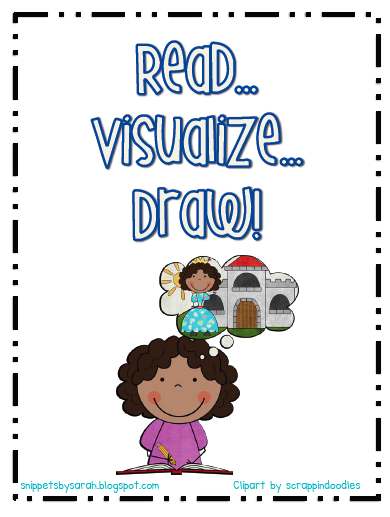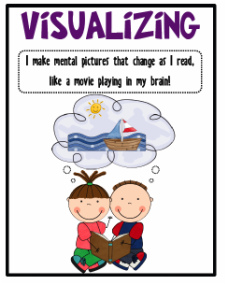What is Visualizing?
Throughout my observations during field experience I have noticed that a lot of my readers visualize what they are reading. Visualizing is when the students create an image in their mind which represent what they are reading. In other words according to Into the Book (2015), visualizing is when students create a movie in their mind as they read. For example, if a student is reading a short story on a person who traveled through the dark, scary forest, the student may create a mental image of the dark and scary forest. They may want to draw a picture to help them comprehend and remember what they read.
As students read they should create images in their head allowing them to actively engage in their reading, which can improve reading comprehension. It is important to discuss with students that each image they draw in their mind, or on paper, will be different because we all have a different imagination and different lived experiences. When students create in image in their mind or on paper, teachers should ask the students to justify why they created that image. Ask them which words in the story helped them create that image and how it made them feel.
As students read they should create images in their head allowing them to actively engage in their reading, which can improve reading comprehension. It is important to discuss with students that each image they draw in their mind, or on paper, will be different because we all have a different imagination and different lived experiences. When students create in image in their mind or on paper, teachers should ask the students to justify why they created that image. Ask them which words in the story helped them create that image and how it made them feel.
Visual Representations
Content Area Examples
Math- Visualizing can be adapted in a math lesson by the teacher doing a read aloud to the students and having them visualize what the teacher is reading. For example, if the teacher is doing a read aloud on different shapes, the students might want to visualize what the shapes might look like. The students can create images in their mind of what they think the shape might look like, and draw it on paper. When the teacher finishes the read aloud, he/she should show the students what the shape looks like. There is no right or wrong answer when the students are creating their images.
Music- This strategy can be adapted in a music lesson by having the students listen to music, visualize how the music makes them feel and what they "see," and then drawing or writing on paper their images. For example, I had my students listen to music, and then draw lines on paper expressing how they felt as the music was playing. If it was a graceful song, the students would draw smooth wavy lines on their paper. If it was a scary song, the students would visualize and draw jagged lines that went all over the page in every which way.
History- Visualizing could be adapted in a history lesson by having the students read a chapter in their history book and visualizing what they see and how the story made them feel. For example, the students may be reading a chapter on Native Americans and their living style. Some Indians lived in Ti Pi's. The students may visualize what Ti Pis look like and draw what they see in their mind.
Art- Visualizing is used in art very often. For example, a teacher might read a book about fall, and have the stunts visualize the story and paint what they see in their mind. The students may use warm colors (red, orange, yellow) when painting a picture about fall. They may paint a picture of themselves jumping in a pile of leaves. There is no correct way to draw what they see. Once the students are done painting their vision from the story, the teacher may have the students share their painting and justify why they drew their image using specific words from the story.
Music- This strategy can be adapted in a music lesson by having the students listen to music, visualize how the music makes them feel and what they "see," and then drawing or writing on paper their images. For example, I had my students listen to music, and then draw lines on paper expressing how they felt as the music was playing. If it was a graceful song, the students would draw smooth wavy lines on their paper. If it was a scary song, the students would visualize and draw jagged lines that went all over the page in every which way.
History- Visualizing could be adapted in a history lesson by having the students read a chapter in their history book and visualizing what they see and how the story made them feel. For example, the students may be reading a chapter on Native Americans and their living style. Some Indians lived in Ti Pi's. The students may visualize what Ti Pis look like and draw what they see in their mind.
Art- Visualizing is used in art very often. For example, a teacher might read a book about fall, and have the stunts visualize the story and paint what they see in their mind. The students may use warm colors (red, orange, yellow) when painting a picture about fall. They may paint a picture of themselves jumping in a pile of leaves. There is no correct way to draw what they see. Once the students are done painting their vision from the story, the teacher may have the students share their painting and justify why they drew their image using specific words from the story.


